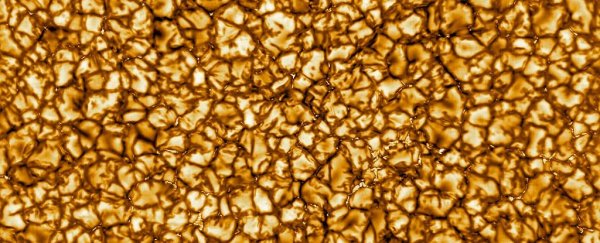Hidden turbulent motion that takes place inside the atmosphere of the Sun can be accurately predicted by a newly developed neural network.
Fed only temperature and vertical motion data collected from the surface of the solar photosphere, the AI model could correctly identify turbulent horizontal motion below the surface. This could help us to better understand solar convection, and processes that generate explosions and jets erupting from the Sun.
"We developed a novel convolutional neural network to estimate the spatial distribution of horizontal velocity by using the spatial distributions of temperature and vertical velocity," wrote a team of researchers led by astronomer Ryohtaroh Ishikawa of the National Astronomical Observatory of Japan.
"This led to efficient detection of spatially spread features and concentrated features. [..] Our network exhibited a higher performance on almost all the spatial scales when compared to those reported in previous studies."
The solar photosphere is the region of the Sun's atmosphere that is commonly referred to as its surface. It's the lowest layer of the solar atmosphere, and the region in which solar activity such as sunspots, solar flares and coronal mass ejections originate.
If you look closely, the surface of the photosphere is not uniform. It's covered with sections crowded together, lighter in the middle and dark towards the edges. These are called granules, and they're the tops of convection cells in the solar plasma. Hot plasma rises in the middle, and then falls back down around the edges as it moves outwards and cools.
When we observe these cells, we can measure their temperature, as well as their motion via the Doppler effect, but horizontal motion can't be detected directly. However, smaller scale flows in these cells can interact with solar magnetic fields to trigger other solar phenomena. In addition, turbulence is also thought to play a role in heating the solar corona, so scientists are keen to understand exactly how plasma behaves in the photosphere.
Ishikawa and team developed numerical simulations of plasma turbulence, and used three different sets of simulation data to train their neural network. They found that, based solely on the temperature and vertical flow data, the AI could accurately describe horizontal flows in the simulations that would be undetectable on the real Sun.
This means that we could feed it solar data and expect that the results it returns are consistent with what is actually occurring on our fascinating, forbidding star.
However, the neural network does need some fine-tuning. While it was able to detect large-scale flows, the AI did have trouble picking out smaller features. Since the accuracy of small-scale turbulence is crucial for some calculations, resolving this should be the next step in developing their software, the researchers said.
"By comparing the results of the three convection models, we observed that the rapid decrease in coherence spectrum occurred on the scales that were lower than the energy injection scales, which were characterized by the peaks of the power spectra of the vertical velocities. This implies that the network was not appropriately trained to reproduce the velocity fields in small scales generated by turbulent cascades," they wrote in their paper.
"These challenges can be explored in future studies."
A bit closer to home, the researchers are developing their software to also help better understand turbulence in fusion plasmas – another important application for future use.
The research has been published in Astronomy & Astrophysics.
